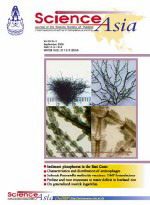ThaiScience
ThaiScience
SCIENCE ASIA
Volume 46, No. 1S, Month MARCH, Year 2020, Pages 79 - 84
Comparison of molded pulps from rice straw, pineapple leaf and banana stem pulps
Phattharasaya Rattanawongkun, Nutchanad Kunfong, Supattra Klayya, Thawan Chotimarnon, Sitthi Duangphet, Nattaya Tawichai, Uraiwan Intatha, Nattakan Soykeabkaew
Abstract Download PDF
Molded pulp is an eco-friendly packaging product popularly chosen nowadays. It is mostly used to replace plastic containers such as polypropylene (PP), polystyrene (PS) and polyethylene (PE). Besides, the non-wood pulps from agricultural crops and residues have been increasingly studied as alternative materials in pulp production. Therefore, this study aimed to investigate the possibility of utilizing rice straw (R), pineapple leaf (P) and banana stem (B) as raw materials to prepare pulps by using a soda-anthraquinone (AQ) pulping process. The pulping was carried out with 4–7% sodium hydroxide solution and 0.1% AQ, a liquid-solid ratio of 10:1, and pulping time of 15–30 min at 98 ± 2 °C. Next, the obtained pulps unscreened (u-) were sieved into screened (s-) portions, and the molded sheets from both u- and s-portions were formed using compression molding technique under pressure of 0.6 MPa at 130 °C for 5 min. The molded sheets from R pulp showed higher tensile strength and tensile index (62 MPa and 63.28 Nm/g, respectively) when compared to the sheets from P and B pulps. From SEM images, the cross-sections of the R pulp sheets revealed less voids between fiber layers and, hence, better fiber-packing and bonding. Based on their mechanical properties compared to commercial molded pulp products, it suggested that these agricultural residues and their pulps can be considered promising alternative sources for pulp and molded pulp production.
Keywords
molded pulp, rice straw, pineapple leaf, banana stem, soda-AQ pulpingSCIENCE ASIA
Published by : The Science Society of Thailand
Contributions welcome at : http://www.scienceasia.org/
